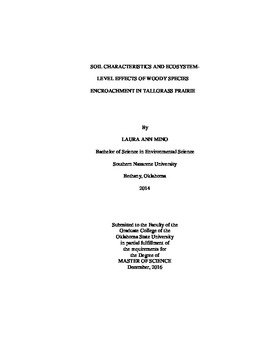| dc.contributor.advisor | Wilson, Gail W. T. | |
| dc.contributor.author | Mino, Laura Ann | |
| dc.date.accessioned | 2018-03-13T18:16:07Z | |
| dc.date.available | 2018-03-13T18:16:07Z | |
| dc.date.issued | 2016-12-01 | |
| dc.identifier.uri | https://hdl.handle.net/11244/54571 | |
| dc.description.abstract | Grasslands across the globe currently experience numerous threats resulting in lost ecosystem services and global biodiversity. In the North American Great Plains, it is estimated that as little as 1% of the historical range of the tallgrass prairie ecosystem remains intact, and these tracts are threatened by a variety of global change phenomena. One of the greatest current threats to grasslands worldwide is the expansion of woody species. Many studies document aboveground consequences of woody species encroachment and have noted changes in multiple trophic levels. However, little research exists on belowground ecosystem-level effects following woody plant establishment, such as shifts in soil microbial community composition, including arbuscular mycorrhizal (AM) fungal abundance, and soil nutrient dynamics. Mycorrhizal interactions have previously been shown to play a critical role in native plant species dominance and contribute to healthy soil function of tallgrass prairie ecosystems. My study assesses abiotic and biotic soil characteristics of native tallgrass prairie and adjacent areas with established stands of the following woody species: Juniperus virginiana, Cornus drummondii, Gleditsia triacanthos, and Rhus aromatica. My results indicate woody encroachment and establishment result in species-specific alterations in biotic and abiotic soil characteristics. For example, encroachment by J. virginiana resulted in increased plant-available P and more alkaline soils, while soils associated with R. aromatica exhibited greater soil organic matter. While C. drummondii or G. triacanthos did not demonstrate significant shifts in nutrient availability, these species altered other soil abiotic characteristics including gravimetric moisture content and soil aggregate stability. Juniperus virginiana and G. triacanthos were associated with greater abundance of AM fungi, both within the roots and in surrounding soil, compared to native soils or soils associated with C. drummondii or R. aromatica. Alteration in soil characteristics may be one mechanism facilitating the rapid conversion of grasslands to woodland species, and may provide challenges to ecosystem restoration following removal of the woody species. | |
| dc.format | application/pdf | |
| dc.language | en_US | |
| dc.rights | Copyright is held by the author who has granted the Oklahoma State University Library the non-exclusive right to share this material in its institutional repository. Contact Digital Library Services at lib-dls@okstate.edu or 405-744-9161 for the permission policy on the use, reproduction or distribution of this material. | |
| dc.title | Soil Characteristics and Ecosystem-level Effects of Woody Species Encroachment in Tallgrass Prairie | |
| dc.contributor.committeeMember | Hickman, Karen R. | |
| dc.contributor.committeeMember | Ochsner, Tyson E. | |
| osu.filename | Mino_okstate_0664M_14975.pdf | |
| osu.accesstype | Open Access | |
| dc.description.department | Natural Resources and Ecology Management | |
| dc.type.genre | Thesis | |
| dc.type.material | text | |
